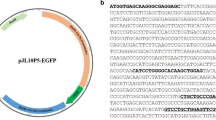Abstract
Protoplasts isolated from embryogenic suspension cultures of wheat (Triticum aestivum cv. Hartog) were electroporated in the presence of plasmid pEmuGN and/or pEmuPAT, which contained the reporter gene gus and selectable marker gene bar, respectively. Under optimised electroporation conditions, up to 0.9% of viable protoplasts displayed gus activity two days after electroporation. To select for phosphinothricin (PPT) resistant colonies, electroporated protoplasts were incubated for six weeks in a medium containing 10 μg/ml PPT. The cells surviving the selection were maintained as individual colonies on solid medium or as suspension cultures. More than 60% of these colonies exhibited tolerance to 40 μg/ml PPT when tested 10 months after initial selection. To date, 57 green plants have been regenerated from these colonies and 24 have been transferred to soil. Southern blot analyses of colonies and plants, using the bar gene sequence as the probe, confirmed transformation of the cells. Positive PAT assays of both regenerated colonies and plants indicated the presence of the bar gene product. These results provide a basis for the establishment of routine procedures for transformation of wheat by direct gene transfer into protoplasts.
Similar content being viewed by others
Abbreviations
- gus:
-
β-glucuronidase
- PAT:
-
phosphinothricin N-acetyltransferase
- PPT:
-
phosphinothricin
- MS:
-
Murashige and Skoog medium
References
Ahmed KZ, Sagi F (1993) Plant Cell Rep 12: 175–179.
Becker D, Brettschneider R, Lörz H (1994) Plant J. 5: 299–307.
Chamberlain DA, Brettell RIS, Last DI, Witrzens B, McEnroy D, Dolferus R, Dennis ES (1994) Aust J Plant Physiol 21: 95–112.
DeBlock M, Brouwer DD, Tenning P (1989) Plant Physiol 91: 694–701.
Doyle JJ, Doyle JL (1990) Focus 12: 13–15.
Ha SB, Wu FS, Thorne TK (1992) Plant Cell Rep 11: 601–604.
Hauptmann RM, Ozias-Akins P, Vasil V, Tabaeizadeh Z, Rogers SG, Horsch RB, Vasil IK, Fraley RT (1987) Plant Cell Rep 6: 265–270.
He DG, Yang YM, Scott KJ (1992) Plant Cell Rep 11: 16–19.
Horn ME, Shillito RD, Conger BV, Harms CT (1988) Plant Cell Rep 7: 469–472.
Jefferson RA (1987) Plant Mol Biol Rep 5: 387–405.
Larkin PJ, Taylor BH, Gersmann M, Brettell RIS (1990) Aust J Physiol. 17: 291–302.
Lee BT, Murdoch K, Topping J, De Both MTJ, Wu QS, Karp A, Steele S, Symonds C, Kreis M, Jones MGK (1988) Plant Cell Tissue Organ Cult 12: 225–228.
Lee BT, Murdoch K, Topping J, Kreis M, Jones MGK (1990) In “Biotechnology in Agriculture and Forestry” (ed). Bajaj YPS Vol 13. Springer-Verlag, Berlin. pp659–668.
Lörz H, Baker B, Shell J (1985) Mol Gener Genet 199: 178–182.
Marsan PA, Lupotto E, Locateli F, Qiao YM, Cattaneo M (1993) Plant Sci 93: 85–94.
Nehra NS, Chibbar RN, Leung N, Caswell K, Mallard C, Steinhauer L, Baga M, Kartha KK (1994) Plant J 5: 285–297.
Oard JH, Paige D, Dvorak J (1989) Plant Cell Rep 8: 156–160.
Ou-Lee TM, Turgeon R, Wu R (1986) Proc Natl Acad Sci USA 83: 6815–6819.
Peng JY, Lyznik LA, Lee L, Hodges TK (1990) Plant Cell Rep 9: 168–172.
Potrykus I (1991) Ann Rev Plant Physiol Plant Mol Biol 42: 205–225.
Rhodes CA, Pierce DA, Mettler IJ, Mascarenhas D, Detmer J (1988) Science 240: 204–206.
Scott KJ, He DG, Karunaratne S, Mouradov A, Mouradova E, Yang YM (1994). Approaches to genetic engineering of cereals. In: Improvement of cereal quality by genetic engineering of cereals, (eds. Henry R & Ronalds JA) Plenum.
Shimamoto K, Terada R, Izawa T, Fujimoto H (1989) Nature 338: 274–276
Vasil V, Castrillo AM, Fromm ME, Vasil IK (1992) Bio/Tech 10: 667–674.
Vasil V, Castrillo AM, Fromm ME, Vasil K (1993) Bio/Tech 11: 1553–1558
Weeks JT, Anderson OD, Blechl AE (1993) Plant Physiol 102: 1077–1084.
Yang YM, He DG, Scott KJ (1991) Aust J Plant Physiol 18: 445–452.
Yang YM, He DG, Scott KJ (1994) Plant Cell Rep 13: 176–179.
Yang YM (1994) Suspension and protoplast culture of wheat. MSc Thesis, The University of Queensland.
Zaghmout OM-F, Wang WC (1992) Anal Biochem 204: 239–243.
Zaghmout OM-F, Trolinder NL (1993) Theor Appl Genet 86: 721–730.
Zhou H, Stiff CM, Konzak CF (1993) Plant Cell Rep 12: 612–616.
Author information
Authors and Affiliations
Additional information
Communicated by H. Lörz
Rights and permissions
About this article
Cite this article
He, D.G., Mouradov, A., Yang, Y.M. et al. Transformation of wheat (Triticum aestivum L.) through electroporation of protoplasts. Plant Cell Reports 14, 192–196 (1994). https://doi.org/10.1007/BF00233789
Received:
Revised:
Issue Date:
DOI: https://doi.org/10.1007/BF00233789




